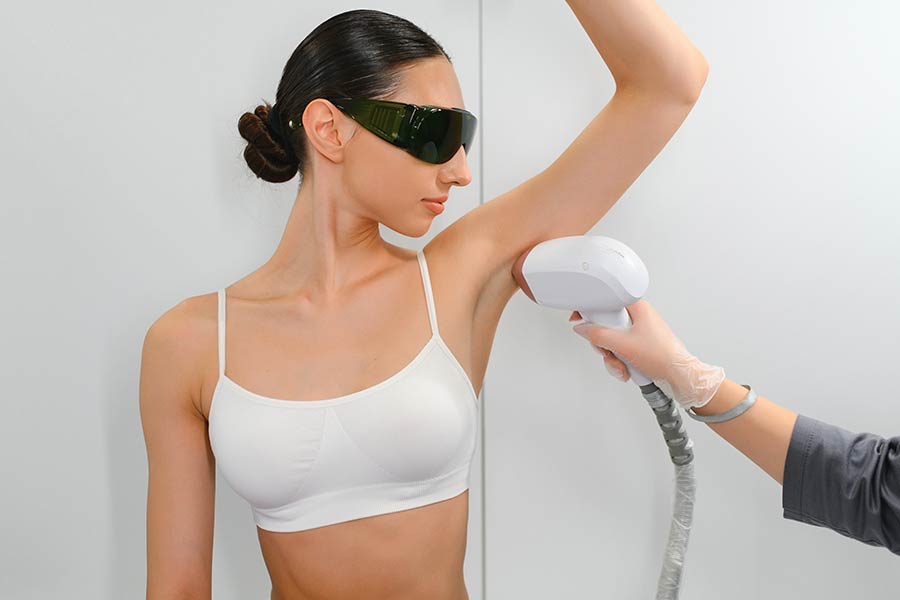Imagine this: you're standing at the threshold of a time machine, ready to step in and travel back through the ages. Your destination? To trace the evolution of a groundbreaking technology that has transformed our approach to personal grooming - laser hair removal. So, fasten your seat belts, and let's get ready to journey through time!
Now, if you're thinking, "Why all the fuss about hair removal?" - consider this. Unwanted hair can be a cause of discomfort for many, affecting self-confidence and overall quality of life. Traditionally, solutions like shaving, waxing, or threading have been at our disposal. But aren't we all too familiar with their fleeting results and the time and energy they consume? In our fast-paced, modern lives, we yearn for something more efficient, more lasting - a silver bullet for unwanted hair. That's where laser hair removal comes in.
In the world of aesthetic treatments, laser hair removal has emerged as a trailblazer. It offers a semi-permanent to permanent reduction in hair growth, and most importantly, it offers freedom - freedom from the daily or weekly regimen of hair removal, freedom from the pain of waxing, and freedom from the skin irritation caused by shaving. No wonder it has become one of the most popular aesthetic treatments globally!
So, what is this popular procedure all about? In a nutshell, laser hair removal uses light to target the pigment in individual hairs. The light travels down the hair shaft and into the hair follicle. This heat from the laser light destroys the hair follicle, which inhibits future hair growth. Sounds simple, right? But you'd be surprised to learn about the complex science and evolution behind this process.
As we prepare to delve into the past and explore the fascinating journey of laser hair removal's evolution, you'll discover the remarkable science, the incremental advancements, and the individuals who have played a part in shaping it. From the first experiments to the sleek, efficient procedures we have today - it's quite a story! Are you ready? Let's step into our time machine and set the dial to the past!
The Birth of Laser Technology
As we hurtle back through time, the first stop on our journey is the mid-20th century. The year is 1960, and American physicist Theodore Maiman is about to make history. He's set to unveil a device that uses a principle called "light amplification by stimulated emission of radiation." Yes, that's quite a mouthful! So, let's call it by the acronym we all know today - LASER.
Now, the idea of lasers wasn't entirely new. Albert Einstein had laid the groundwork for it in 1917 with his theory of stimulated emission. However, turning theory into practice took several decades, several brilliant minds, and not to mention, several failed attempts. When Maiman finally created the first working laser, it was nothing short of a breakthrough. Little did he know that his ruby laser would become the cornerstone of modern technology, reaching far beyond its initial applications in industry and science, and transforming cosmetic procedures forever.
Fast forward a few years to 1963, and our story gets more intriguing. Enter Dr. Leon Goldman, often referred to as the 'Father of Laser Medicine.' It was Dr. Goldman who first saw the potential of laser technology in the medical field. His pioneering work, though initially met with skepticism, gradually gained acceptance. Dr. Goldman's studies demonstrated that lasers could have a therapeutic effect on the human body, marking the first step towards the cosmetic use of lasers.
So, how did we leap from lasers in the lab to lasers in the beauty salon? Well, imagine you're a scientist in the 1960s, gazing at a laser device. You see its power, its precision. And then it hits you - could this technology be harnessed to target something as small and specific as a hair follicle? The seed of an idea is planted. Yet, as any gardener will tell you, it's one thing to plant a seed, but quite another to make it grow.
The concept of using lasers for hair removal seemed promising, but turning this concept into reality was no mean feat. It required the convergence of technological advancements, medical research, and a growing demand for cosmetic treatments. This convergence took years, but when it happened, it changed the face of personal grooming. Curious to know more? Hang tight as we journey further down the timeline, exploring the trials, tribulations, and triumphs that led to the modern laser hair removal procedures we know today.
Early Experiments and Challenges
Have you ever tried to assemble a puzzle without knowing what the final picture should look like? That's a little like what scientists and researchers faced in the early days of laser hair removal. They had this powerful tool – the laser – but the path to effective, safe, and efficient hair removal was not entirely clear. So, they started to experiment.
Imagine, if you will, those first few attempts. They knew that lasers could heat things, so the idea was to use that heat to damage the hair follicle without harming the surrounding skin. Simple enough in theory, but a Herculean task in practice. Scientists needed to find the sweet spot – the right laser type, the precise wavelength, the perfect duration – all factors that could make or break their mission.
Remember, this was uncharted territory. The first lasers used for hair removal were ruby lasers, the same kind developed by Theodore Maiman. While they showed some promise, the results were inconsistent, and side effects were common. The laser's light was well absorbed by the melanin in hair, but also by the melanin in dark skin, which led to burns and skin discoloration. On top of this, the ruby laser had a small treatment area and a slow repetition rate, making the procedure time-consuming. Not exactly a winning combination!
But just as it seemed like they had hit a wall, a new player entered the scene – the alexandrite laser. Offering a longer wavelength, the alexandrite laser was less absorbed by the skin's melanin and more absorbed by the hair, thereby reducing skin damage. It also had a faster repetition rate and a larger treatment area, making the process quicker and more efficient. It seemed like the solution to the puzzle was within reach.
Yet, the road to innovation is rarely smooth, and the journey of laser hair removal was no different. Despite these advancements, challenges persisted. There were issues with pain during treatment, temporary results, and difficulties treating people with darker skin tones or lighter hair colors. These hurdles did not deter the scientific community, though. Instead, they fueled the fire of determination, sparking more research and experimentation, ultimately leading to the varied and versatile laser hair removal methods we see today. But how did we get there? Keep reading as we continue to chart this fascinating journey.
The First Generation of Laser Hair Removal
Have you ever watched an old black-and-white movie and marveled at how far film technology has come? That's somewhat akin to looking back at the first generation of laser hair removal devices. They were breakthroughs in their time, but viewed through the lens of today's technology, they feel a bit like relics. But just as those early films laid the groundwork for today's cinematic masterpieces, the initial laser hair removal devices paved the way for the sophisticated systems we have now.
Let's journey back in time, to the mid-1990s, when the first laser hair removal device was granted FDA approval. This device was equipped with a ruby laser, which, as we've previously discussed, had some significant limitations. However, it was also a game-changer. It introduced the world to the concept of "photo-epilation," or removing hair using light, and people were intrigued.
But, just as a movie-goer might enjoy a black-and-white film while noting its lack of color, the public had a mixed response to these first devices. On the one hand, they offered a new, non-invasive option for hair reduction - a huge plus for anyone tired of shaving or waxing. On the other hand, treatments were lengthy and uncomfortable, the risk of side effects was high, and the results varied. Laser hair removal had entered the public consciousness, but it was far from perfect.
The limitations of the ruby laser were soon recognized, and the Alexandrite laser took center stage. Its longer wavelength provided safer and quicker treatments, but it still had a major drawback: it wasn't suitable for darker skin tones. We see a lot of this trial and error in the early days, don't we? It's like trying to adjust the settings on an old television set - tinker with the color, and the contrast goes off. Adjust the contrast, and the brightness needs tweaking.
Despite these initial hurdles, the first generation of laser hair removal devices created a foundation. They demonstrated that the concept was sound and that the demand was there. As with all technology, it was a stepping stone to better things, and soon, advances would usher in the second generation of laser hair removal devices. But let's not get ahead of ourselves. That's a tale for our next section. Stay tuned as we continue exploring this fascinating journey of technological evolution!
Continuous Evolution and Improvement
Imagine you're watching a series where each season gets more compelling than the last. The first season was riveting, but it had its flaws. The creators took feedback from the audience, improved upon the weaknesses, and brought in new elements that made the series even better. That's pretty much what happened with the evolution of laser hair removal technology. Just as our favorite series wouldn't have stopped at season one, the cosmetic industry didn't rest on its laurels with the first generation lasers.
Recognizing the limitations of the ruby and Alexandrite lasers, scientists and researchers hit the drawing board, seeking better, safer, and more efficient options. The early 2000s marked the introduction of the Nd:YAG laser, a significant leap in laser hair removal technology. With a much longer wavelength, this laser could safely treat darker skin tones, addressing a major shortcoming of its predecessors.
However, like every new season that introduces a major plot twist, the Nd:YAG laser brought in its own set of challenges. The longer wavelength could treat darker skin, yes, but it also made treatments more painful. It was like upgrading to a larger TV but realizing the sound quality wasn't quite up to par. There was progress, but there was still room for improvement.
Responding to these challenges, the industry began exploring cooling methods to reduce the discomfort during treatments. Can you imagine the excitement of fans when their favorite character is saved in a seemingly impossible situation? That's the kind of relief these cooling mechanisms brought. They transformed the laser hair removal experience, making it more comfortable and thus, more appealing to a broader audience.
Around this time, we also saw the emergence of IPL or Intense Pulsed Light technology. This wasn't a laser, but it used a similar principle and was another method for hair reduction. It's like a spin-off series that has its own unique charm but still ties back to the original.
In the years that followed, there were further advancements in laser types, cooling methods, and even devices for at-home use. Like a show that only gets better with each season, the evolution of laser hair removal technology brought continuous improvements, addressing previous challenges and providing better, safer, and more effective treatments. As we look back, it's clear to see why laser hair removal has become such a popular method for hair reduction. But stay with us, as there's still more to explore in this fascinating journey.
Introduction of Different Wavelengths
Let's picture the world of laser hair removal as an ever-evolving party, where everyone is trying to find their perfect dance partner. In the beginning, there were only a couple of options, and while they could set the dance floor on fire, they weren't suited for everyone. Enter different wavelengths, each like a new dance style, allowing people with various hair and skin types to join the fun.
Think about it this way. Laser technology works by targeting the pigment in the hair. This pigment absorbs the laser light, which then destroys the hair follicle. But different hair and skin types require varying degrees of laser light intensity. It's like every dance style has its own rhythm and tempo. You wouldn't do a waltz to a rock song, would you? Similarly, you can't use the same laser wavelength for all hair and skin types.
The early ruby and Alexandrite lasers had shorter wavelengths. They were like a quickstep, perfect for lighter skin tones and dark hair, but they faltered when it came to darker skin. The shorter wavelength was more readily absorbed by the skin's pigment, leading to burns and pigmentation issues. It was like asking someone with two left feet to perform a fast-paced dance number. It just wasn't a good match.
The introduction of the Nd: YAG laser with its longer wavelength changed the game. Imagine going from a quickstep to a slow dance, more suitable for those with darker skin tones. The longer wavelength penetrated deeper and was less likely to be absorbed by the skin's pigment, reducing the risk of burns and pigmentation changes.
This marked a significant evolution in laser hair removal treatments, leading to more personalized procedures. Everyone could now find their perfect dance partner, so to speak. The introduction of different wavelengths meant that treatments could be tailored to individual needs, offering safer and more effective results. It wasn't just about joining the party anymore, it was about enjoying the dance. And this, my friends, was just one of the fascinating steps in the journey of laser hair removal technology.
Cooling Mechanisms and Safety Measures
Imagine a summer day, the sun beating down mercilessly and the air thick with heat. You'd love to dance to your heart's content, but without some form of cooling, you'd overheat and risk harming yourself. The same principle applies to laser hair removal treatments. As the laser zaps away at the hair follicles, it generates heat, and without proper cooling, this can cause discomfort and potentially skin damage. It's like trying to salsa dance in the sweltering summer heat without a fan or air conditioning - it just doesn't work.
Fortunately, just as air conditioners revolutionized summer dancing, cooling mechanisms transformed the laser hair removal industry. It's like when the DJ suddenly brings out a powerful cooling fan - it doesn't just make the party more enjoyable, it makes it safer too.
These cooling systems work in two ways: protecting the skin from the heat generated by the laser and reducing the discomfort of the procedure. It's akin to wearing a protective layer while dancing near the bonfire or having a glass of chilled water nearby to cool down when the dance gets a bit heated.
Various cooling methods have been incorporated over time. Remember when we first got handheld fans? It's like the air-cooling technique used in the initial days. Although it provided some relief, it wasn't the most efficient. Then came contact cooling, where a cooled transparent gel or a cooled sapphire window at the tip of the laser is placed against the skin, much like a cold towel on a hot forehead.
Eventually, we saw the introduction of cryogen spray cooling, which briefly sprays a cooling agent on the skin before each laser pulse. This is like having an instant burst of cold air right when you need it, allowing you to keep on dancing without missing a beat.
The inclusion of cooling mechanisms and other safety measures allowed laser hair removal to become safer and more comfortable. It's like a well-hosted party where the organizer not only ensures everyone is having a good time but also takes steps to ensure everyone's safety and well-being. In essence, laser hair removal evolved from a basic dance party to an exquisite, well-planned ball, caring not just for the results, but for the journey as well.
Modern-Day Laser Hair Removal
Let's picture a skilled violinist. A virtuoso who effortlessly glides the bow over the strings, each note resonating with clarity, precision, and beauty. The violinist, armed with years of practice and the most refined instrument, creates a symphony that mesmerizes and captures the audience. This is much like the modern-day laser hair removal techniques: precise, efficient, and meticulously designed to captivate their audience.
In comparison to the first generation of laser hair removal treatments, today's techniques are like a finely tuned Stradivarius compared to a beginner's violin. They're both fundamentally the same, but the difference lies in the artistry, precision, and results.
One of the key features of contemporary laser hair removal treatments is their versatility. Different lasers, such as the Alexandrite, Nd:YAG, and Diode lasers, with their unique wavelengths, are tailored to treat different skin and hair types. It's like a concert where the violinist skillfully switches between classical, jazz, and pop genres to cater to the varied tastes of the audience.
Moreover, the precision of modern laser hair removal treatments is a game-changer. We're now able to target individual hair follicles without affecting the surrounding skin. It's as if the violinist can play a melody on one string without even brushing against the others.
Speed is another incredible development. Many of today's devices offer rapid pulse rates, meaning they can treat a larger area in less time. Imagine the violinist's fingers moving swiftly over the strings, delivering a fast-paced, exhilarating performance that keeps the audience enthralled.
Finally, and perhaps most importantly, is the enhanced comfort and safety. With sophisticated cooling mechanisms and precise energy delivery, the risk of side effects has dramatically decreased. Just as the violinist ensures that the beautiful music doesn't reach a volume that could harm the audience's ears.
To summarize, modern-day laser hair removal is a symphony of science, technology, and artistry. It’s a beautifully orchestrated performance, delivering a precise, efficient, and safe solution to those seeking liberation from unwanted hair. And just like the anticipation of the violinist's next performance, the future of laser hair removal holds unbounded potential and excitement.
Tailored Treatments and Versatility
Imagine attending a lavish banquet where the chef meticulously customizes each dish to suit every guest's dietary preferences and palate. Vegetarian, gluten-free, spice aficionados or lovers of milder flavors - everyone's catered for. This, my friend, is the beauty of tailored treatments in the realm of modern laser hair removal. Just as the chef considers individual preferences, laser hair removal has evolved to consider individual skin and hair types.
Today, laser hair removal isn't a one-size-fits-all affair. It's an intricately tailored experience, just like that banquet, designed to suit a diverse range of people. Remember when we discussed the introduction of different laser wavelengths? That wasn't just a technical upgrade; it was a pivotal step in personalizing treatments.
Different lasers are now employed to cater to different skin tones and hair types. For instance, the Alexandrite laser, which has a shorter wavelength, is particularly effective on lighter skin tones. The Nd:YAG laser, with its longer wavelength, is the go-to for darker skin types. So, whether you're as fair as Snow White or have a gorgeous darker complexion like Lupita Nyong'o, there's a laser for you.
But, it's not just skin tone that we're considering. Hair color plays a pivotal role too. Darker hair absorbs more laser energy, which makes it easier to treat. But don't fret if you've got lighter hair. Technological advancements mean that effective options for lighter hair are growing by the day.
And it's not just about body hair removal anymore. Did you know that certain lasers can safely treat facial hair too? Imagine being able to say goodbye to threading or waxing your upper lip or chin!
The power settings, pulse durations, and cooling mechanisms of these high-tech devices can also be fine-tuned, ensuring not just effective treatment, but also a comfortable one. It's akin to adjusting the spice level of your dish at the banquet. You get to enjoy the meal without the discomfort of it being too spicy for your liking.
In conclusion, modern laser hair removal has truly broadened its horizons, extending its benefits to more people than ever before. It’s like a culinary feast that caters to every preference, ensuring every guest leaves satisfied. The evolution of laser hair removal has been, and continues to be, an exciting journey of innovation and inclusion.
Regulatory Standards and Professional Training
Just like you wouldn't want an untrained chef whipping up your dinner at a 5-star restaurant, you wouldn't want someone without the proper training and certification handling your laser hair removal treatment, would you? That's exactly why professional training and regulatory standards are crucial components in the world of laser hair removal today.
We're not just talking about running a laser across someone's skin. Laser hair removal is a sophisticated process. It involves understanding skin and hair types, knowing how to adjust laser settings accordingly, and being aware of safety protocols to prevent injuries. Hence, professional training becomes as critical as learning how to perfectly sear a steak in our culinary analogy.
The road to becoming a laser technician involves thorough training courses and practical experience. Courses delve into topics like laser physics, skin anatomy, laser safety, and even client consultation skills. This rigorous training ensures that every laser technician is equipped to provide safe and effective treatments. Just as every top chef needs to understand different cooking methods, every laser technician needs to master different laser techniques.
Along with training comes the important aspect of regulation. In the same way that the food industry has watchdogs like the FDA, the world of laser hair removal has its regulatory bodies too. These organizations, such as the U.S. Food and Drug Administration (FDA) and the British Medical Laser Association (BMLA), help maintain high safety standards and ensure that any laser device on the market is tested and declared safe for use.
Moreover, the laser hair removal industry is also governed by state-specific laws and regulations. These may include who can perform laser treatments, what qualifications are required, and what safety measures need to be in place. In essence, these regulatory standards act like a recipe that must be strictly followed, ensuring consistency and safety in every treatment, just as every dish at your favorite restaurant tastes just as perfect every time you order it.
In conclusion, professional training and regulatory standards are the secret ingredients that ensure the safety and success of modern laser hair removal. They're what keep the industry advancing while maintaining high safety and service standards. After all, what good is a beautifully laid banquet if the food isn't prepared safely and expertly, right?
The Future of Laser Hair Removal
Just like we eagerly look forward to the next season of our favorite show, don't we all wonder what's next in the saga of laser hair removal? If the past is any indication, we can only expect the future of laser hair removal to be even more exciting, promising, and tailored to individual needs.
So, let's get out our crystal balls and dive into some speculations, shall we?
Firstly, let's talk about technology. With the rapid advancement in technology, we're bound to see even more efficient, faster, and less painful laser systems. Think of it like upgrading from a flip phone to a smartphone. We might see lasers that can target hairs at different stages of growth, drastically reducing the number of treatment sessions required. Wouldn't that be a time-saver?
But wait, that's not all! The future might hold solutions for those who are currently unable to benefit from laser hair removal due to light hair or dark skin. Imagine a world where laser hair removal is a viable option for everyone, regardless of hair or skin type. Now, that's inclusivity in action!
Furthermore, we might also see an expansion in the use of at-home laser hair removal devices. These tools, already growing in popularity, could become as commonplace as electric toothbrushes or hairdryers. However, these devices will still need to be carefully regulated to ensure safety and effectiveness. Because let's face it, who wants a DIY project to turn into a DIY disaster?
In terms of trends, we could expect an increase in personalized treatment plans. Rather than a one-size-fits-all approach, treatments might be extensively tailored to match individual hair growth cycles, skin sensitivity, and desired results. It would be like having a bespoke suit, but for your skin!
Finally, with an increasing focus on sustainability and eco-friendliness, the future might witness the rise of 'green' laser hair removal technologies. These could be devices with low energy consumption, long-lasting components, and recyclable parts. Just imagine contributing to saving the planet while also keeping your skin smooth and hair-free!
While it's impossible to predict the future with 100?curacy, we can say with confidence that the future of laser hair removal looks bright, just like the lasers used in the treatment! This evolving field, guided by technological advancements and consumer trends, promises to continue revolutionizing the way we manage unwanted hair. The future, it seems, is just a laser beam away!
Conclusion
Well, folks, it's time to wrap up our journey through the evolution of laser hair removal. We've traveled a long way from the initial, somewhat daunting lasers of the first generation, through continuous improvement, the introduction of different wavelengths, to modern day laser hair removal. Can you believe how far we've come?
Just think about it: we started with those early models, which, while pioneering, had their fair share of limitations. But did that stop the march of progress? Absolutely not! Innovators and researchers rolled up their sleeves and set out to transform these tools, ushering in the continuous evolution and improvement phase. And boy, did they make some strides!
In time, we saw the introduction of different wavelengths. This was like unlocking a secret level in a video game, allowing practitioners to cater to a broader range of hair and skin types. With the addition of cooling mechanisms and other safety measures, the process became not only more effective but also more comfortable and secure.
Fast-forward to the present day, and we're looking at state-of-the-art technology that offers safe, efficient, and precise hair removal. Tailored treatments have become the norm, with devices adjustable to individual skin and hair types. And let's not forget the importance of professional training and regulation in maintaining high safety standards in the industry today.
But the story doesn't end there. We've gazed into the future, speculating on potential technological advancements and trends. What does it hold? More efficient lasers? Personalized treatment plans? Eco-friendly technologies? Only time will tell, but we can safely say that the future is bright.
So, after this journey, if you've been on the fence about laser hair removal, now might be the time to hop off and embrace this amazing technology. It's safe, effective, and evolving - just like us! So, why not give it a shot and wave goodbye to unwanted hair?
Remember, the story of laser hair removal is a testament to human ingenuity and the relentless pursuit of better, more efficient solutions. It's a story of evolution, growth, and the drive to continuously improve. It's a story that, in many ways, mirrors our own individual journeys. So here's to the journey of laser hair removal, and here's to our own paths towards self-improvement and growth!












